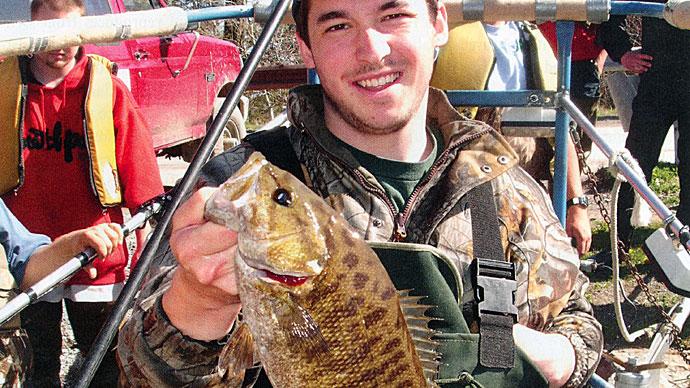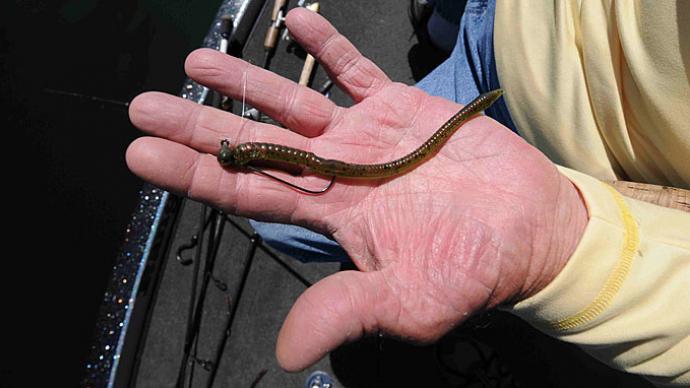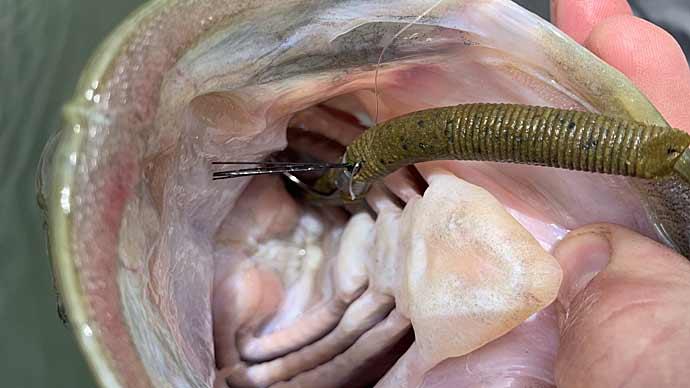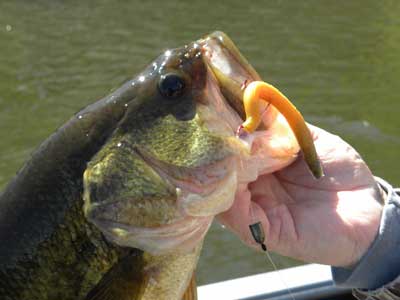
Through the years in bass fishing, milestones have turned and made bass fishing history. In 1949 when Nick Cream developed the first plastic worm, that was something that not only changed the face of bass fishing but influenced fishing as a whole. The introduction of the plastic worm allowed many other bait shapes that followed in the later years. The Texas rigged worm started making an immediate impact that still lingers today.
In the mid-'80s, another volley came to the bass market, the Slug-Go. It was a bigger soft plastic bait that you would rig with a weightless Texas rig. The Slug-Go would glide around in the water and sink under the surface when cast out. It imparted an action like a stickbait up, down, and side to side when twitched. The Slug-Go was a huge craze to hit many bass tackle boxes. Although it sold many baits initially, it did not have the catching and staying power of some of the other lures that came before it.
About ten years later, in the mid-'90s, another soft plastic bait changed the face of bass fishing. In my opinion, this is one of the baits that had that much of an impact back then and still does today. The bait that I am talking about is the Senko. Gary Yamamoto had the intention of making a better version of the Slug-Go. However, rumor has it while drawing different pictures of baits on a whiteboard, the Bic marker that he had in his hand inspired the design of the newest soft bait shape that would dominate bass fishing in the upcoming future. At that point, the Senko started to come to fruition and take its place in bass fishing history.
Let’s break down the soft plastic stickbait and cover some Spring tactics that will help you put more bass in your boat this season.
For me, I have fished many different soft stickbait versions out on the market. I was impressed with some, and others I would give away after fishing only a couple of baits out of the bag. I use Big Bite Baits Trick Sticks of all the stickbait that I have fished. I like the size options that Trick Sticks give me, and I am also impressed with the durability that I get out of these baits.
Un-Weighted & Weighted Texas Rig
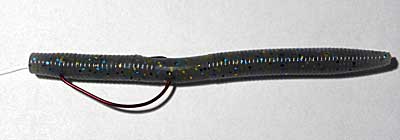
Many of the baits were rigged un-weighted during the early days of stickbait fishing. The natural shimmy action of the weightless lures quickly became popular because it triggered bites from bass. This presentation followed in the footsteps of the bait known before it, the Slug-Go. The rigging of the stickbait included taking your EGW hook and rigging the Tickstick Texas-style.
You have a few different options for fishing un-weighted Trick Sticks. I fish mine on a 7ft medium-action spinning rod paired with a Lew’s size 20 reel spooled with Sunline Asegai 10lb braid with 8lb Sunline Maboroshi FC leader. From time to time, I'll also fish a 7ft medium baitcaster setup teamed with a Lew’s reel that is spooled with 12lb Sunline Sniper.
Weighted Trick Sticks
With the limited situations that you can fish an un-weighted Trick Stick, I started to add weight to my rigging. When rigging and picking weights, don't overpower the bait. Let the natural action of the bait shine through. If you rig it with too much weight, you will remove the Trick Stick's natural action and motion.
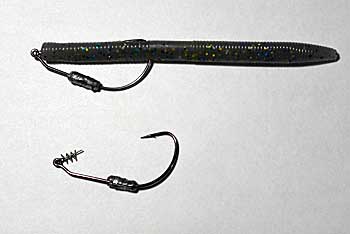
1/16oz and 1/8oz slip sinkers are the main ones I use, with 1/16oz as my number one choice. I'm selecting to use a little weight to improve my presentation speed and cover water faster.
I will also use a second presentation for fishing a Trick Stick. I will take a Mustad EWG jig hook and crimp a 1/8oz swimbait sinker onto the hook shank, then install an Owner Twist Lock onto the eye of this hook. This rig gives my Trick Stick an utterly different action because the weight placement is different on the bait. The bait has a forward fall and gliding action when using a slip sinker. When you use the jig hook rigging, the weight is just short of the middle making the bait fall more vertically with a swimming movement. Bass sitting under the bait will come up to meet this bait as it falls, just like they do with a falling tube bait.
This rigging gives me a distinctive look all season long that is a go-to when the bass are positioned on the edges of weeds and cover.
I will fish my weighted Trick Sticks on a 7ft medium-action baitcaster teamed with a Lew's baitcaster reel spooled with Sunline Sniper FC in 12lb to 16lb line. I let the cover dictate what size line I use.
Jig Head Rigged Trick Sticks
With bass sitting on weed edges or top of the weeds patrolling for food, take a jig head and rig on a Trick Stick and start fan casting the area. Many times, you won't even feel the bite. Instead, you will start to see your line move. Then, it's time to reel down and set the hook.
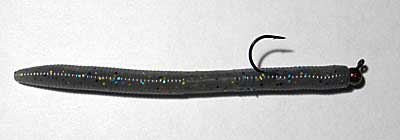
Change your Trick Stick size to match the forage you're trying to imitate. I match 3", 4", and 5" Trick Stick to the conditions that I'm fishing. I use 1/16oz or 1/8oz jig heads for this pattern.
It's vital that you undersize your jig head for this tactic. If you use too heavy of a jig, it will fall into the weeds and get fouled. It won't stay on top of the weeds. Your goal is to keep your bait up on top of the weeds where it can be seen. Under sizing your jig also slows the fall of your presentation and is a great way to trigger bites. Bass will be roaming up over the tops of the weeds or in them, looking for easy prey to eat.
I'll use a 7ft medium action spinning setup with a Lew's size 20 spinning reel spooled with Sunline Asegai 12lb braid with 8lb Sunline Super Natural for weed presentation tactics Sunline Super Natural monofilament leader. I choose Super Natural for my leader because mono floats, which slows down the fall rate of my bait, triggering more bites before the bait hits the weeds.
Now take this same presentation and make a few slight changes, and head deeper in the water column, and you can change gears to a Ned Rig presentation. Again, pay attention to the depth you're fishing and match the jig head to these conditions. I use either a 1/8oz or 3/16oz jig head as a rule of thumb for Ned fishing. I will pair my jigs with either a 3" or 4" Trick Stick for this tactic.
There is something about a small bait moving on the bottom. Bass think of this as a craw or small baitfish on the move. It's an easy meal that is hard to pass up to the bass. Bass will often eat this defenseless bait more times than pass it up.
When fishing the Ned rig presentation, I'll make a few changes to my setup. Rod, reel and the line will be the same, but I'll make a leader change. I will change to an 8lb or 10lb Sunline Maboroshi FC leader. I'm looking for the added sensitivity and hook setting power with my Ned Rig setup that a Fluorocarbon leader gives me.
Wacky Rig Trick Sticks
Just like a Texas rig, a Wacky Rig can be fished weighted or un-weighted. I will match my rigging choice to the conditions I faced with fishing on the water. The quick way to rig your Wacky rig is to take your Trick Stick and fold it in half and run a hook through the middle of your bait. It will get you started, but to get more action out of your Wacky Rig and to extend the life of your bait, you should put a collar onto your Trick Stick.
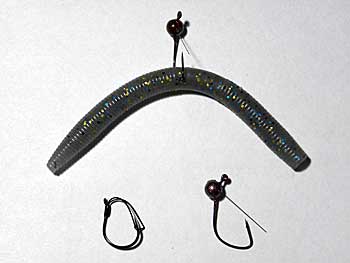
There are a few ways to do this. The simple way is to use an O-Ring. For many years this is what I did. I also took a tactic from Shin Fukae, cut a heat shrink tube length into 3/8" sections, slid it over my Trick Stick, and then used a lighter to slightly heat the tube to snug it around the stick. That gave me a section to run my hook through and made it on some occasions a bait that lasted through 12 bass or more before I had to replace the bait. I use a Gamakatsu Finesse Wide Gap Weedless drop shot hook. This tactic saved me a lot of time and baits when fishing during tournaments. Another choice is the VMC Crossover collar. This collar has holes to let you rig your bait, Wacky style or Neko style. These collars come in a few sizes to accommodate different-sized baits and come with pliers to help rig the collar in place.
Big Bait also makes a Trick Stick that has an O-Ring molded right into the bait, so all you do is put your hook through the O-Ring, and you're set up and armed to go. This Trick Stick is called Wacky Stick in the Big Bite lineup.
If I need to probe deeper water areas, I'll use a Wacky jig that I make myself from a Do-It mold, or I use the Gamakatsu G-Finesse Jig Head Wacky.
For my Wacky Rig tactics, I fish a 7ft medium spinning setup paired with a Lew's size 20 spinning reel spooled with 12lb Sunline Asegai braid and 8lb or 10lb Sunline Maboroshi FC leader.
I hope these Trick Stick tactics and riggings help you put more bass in your boat this spring and all season long. Don't look at this tactic as one just for Spring. These tactics can be fished all season long. There is no time in my boat that I don't have a couple of Trick Stick rods rigged and ready to go.
BassResource may receive a portion of revenues if you make a purchase using a link above.


